Ian overlooks his kingdom. This is on a wharf just south of Greenwich - we had a long ride ahead of us.
My oldest pal in London is a bloke called Ian - we met in 1992 labouring for minimum wage on the new British Library building site. Back then Ian was 18, whippet thin and crazy about DJing and raving. Over the years we kept bumping into one another - at a squat party, on the streets of Lisbon, at a free festival - and then losing contact until, at some point earlier this century, we managed to exchange emails and then mobile numbers: on Friday we were trying to work out how we stayed connected in Lisbon in 1998 when neither of us had mobile phones. I didn’t get one until around 2005. Smoke signals, I guess.
Anyway, considering we’re now older and more settled and both live in SE London we do like to meet for a cycle. During lockdown Ian saved my sanity by getting me to join him on epic cycles around and out of London. Doing so ensured I ended up as slim as I’d been in early 20s! Lockdown was punishing for many but bliss for cyclists, as there were so fewer vehicles on the roads. Now we still venture out, but not quite so far.
Last Friday we met at our usual destination, the landlocked Cutty Sark clipper in Greenwich, then followed the Thames path south. Once in lockdown we went all the way into Kent and arrived at the tiny church Dickens mentions in Great Expectations. On Friday we only went as far as Woolwich, then crossed the river and headed back towards the City for art and music. And ale - every cyclist dreams of ale when pedalling.
They look like what the Cybermen from Dr Who might call home but this is, in fact, the Thames Barrier and designed to protect London from flooding. With global warming they could soon be put to test.
Cycling - or walking - the Thames Path is a treat. It’s a long and often broken up trek that, I believe, stretches from the western regions outside London all the way through to Kent. I have a pal who tries to walk sections of it each time he visits London. Going West I’ve cycled as far as Hampton Court Palace - it’s remarkable how different the west London Thames Path is to the south east trek. A lot leafier and posher? A lot!
Having met at the Cutty Sark we began our trek by cutting through the former Naval College - these buildings were designed by Christopher Wren, Britain’s architectural genius for the ages, and one has a truly baroque painted ceiling - that are now part of a college music department (at times, you will hear the beautiful sound of cellos or violins playing). Exiting we got on the Thames path by the Trafalgar pub - being right on the river makes it a tourist hub and the Trafalgar is decorated to draw attention.
It’s narrow around here with lots of pedestrians so we cycle slowly, passing a 17th C alms house for old sailors (and one that is still functioning; I like to think how, in a few years time, I might end up here one day. That I’m not a sailor is not part of my consideration) and then the Cutty Sark pub - this is a Georgian tavern and a nice place for a pint by the river, but too early in the ride for us to stop and sup.
Immediately you are in industrial terrain - there are huge wharves and decommissioned power stations and areas where sand and other materials are loaded. You don’t get this array of industrial history on the West London Thames path! Greenwich was once a major dock for ships and also a heavy industry hub - the Thames was a working river until the 1970s, when the container ships grew too large to sail up this far. The Thames path here can be extremely narrow so we have to cycle carefully in case coming around a corner are pedestrians/joggers/other cyclists.
We next passed the Greenwich 02, yes the Dome that hosts concerts and sporting events by those who can fill a 20,000 seat arena. I saw Beyonce here - she was brilliant! Bey understood how to fill a concrete bunker with light and sound - and the Stones 50th anniversary: they were only occasionally inspired, Charlie’s drumming and Daryl’s bass playing were the best things going - and Dolly Parton (far too huge a space for her “gee shucks I'll play my banjo now” show) and Iron Maiden (just heavy metal panto’, dull and corny) and, worst of all, Neil Young, who was just abysmal, he made so little effort, treated his fans with contempt (I wasn’t one but that gig confirmed to me that NY is the laziest, lamest classic rocker working).
Generally I avoid arena shows but I was tempted by those big names; as only Queen Bey delivered its unlikely I would venture inside again, yet some people pay to see comedians here…WTF? “Honey, the speck in the distance is telling a joke…” The O2 is also home to the Indigo, a smaller venue (circa 1500 capacity) which lacks comfort/atmosphere but does occasionally book some interesting R&B artists.
The redevelopment around the 02 sees lots of new apartments having been built and all kinds of chain cafes and restaurants opening. There’s open areas for people to stroll and kids to play. Yes, it’s corporate and rather soulless, but as it’s a new London neighbourhood I’m interested in seeing how the area develops.
There are various contemporary sculptures both in the river and on land as you head down the path. One is a large chuck of a former container ship fastened in the river. Then there’s a dreadful Damien Hirst hunk of bronze kitsch by the Thames cable car (which crosses the river). I’ve only ever been on the cable car once and that was with Ian when we decided to use it so to cross the river here. An enjoyable if brief lift over the river.
On Friday we cycled past the cable car, past many new apartment blocks - these are not social housing but expensive homes built for young professionals or international investors: how many, I wonder, exist only as Air B&Bs? They have certainly built hundreds of them - following the river until we hit the Thames Barrier. Which, as the photo demonstrated, looks like a set from an old sci-fi TV show.
Passing the Thames Barrier we hit a now seemingly disused industrial estate - see the photo above. Part of it has been transformed into artist studios; the studios are by the river and its a paradox of our post-industrial age to think how this area once was where things were mass produced (or stored in warehouses) then loaded onto ships while now its where creatives make all manner of art. Some of which, I guess, ends up in the new apartments we have been passing. I imagine this area is waiting for demolition and ever more tower blocks offering chic apartments will be built.
Ian also noted a police station set in one of the old industrial estates - interesting that they base themselves here (good parking and lots of room, I imagine) as there is little real “community” of sorts to represent. There remains a ghost town atmosphere to this stretch of the Thames path - new tower blocks that might largely be empty and decaying buildings from a century+ ago.
Speaking of decay, as we cycled through the estate above we turned left and followed a ramp so we were again above the river. And looking down on the slowly sinking ship above. This is the Royal Iris and, when there is a high tide, the river engulfs the lower decks. The boat was built in Dunbarton in 1950 before being brought down to Liverpool. It operated on the Mersey for 40 years, ferrying passengers around the city.
Thanks to its on-board bar and fish and chip shop it was also known as “the booze boat”, “the love boat” and “the fish and chip boat”. In its heyday it also became a significant venue in the Merseybeat scene with bands like Duke Duval, The Beatles and Gerry & The Pacemakers playing on the ship.
It had a lasting impression on Paul McCartney who mentioned the boat in his song "That Was Me". He sung: "Well that was me, Royal Iris, on the river; Merseybeat n' with the band, that was me" (thanks to the MyLondon blog for info’ on the ship’s history). The Iris was decommissioned years ago and apparently ended up moored here circa 2002, an entrepreneur thinking they would relaunch it as a new enterprise (then didn’t), and it began sinking in 2010, being left to decay into the river ever since.
Some nostalgic Liverpudlians would like to see the Iris restored and returned to Liverpool to serve as part of that city’s Beatles-themed tourist attraction. But, let’s face it, that’s not going to happen. Oh, note the Thames Barrier hovering in the background of the photo.
On we cycled, the housing along the river now 1960/70s era council estates, much smaller and scruffier than the new build apartments just up the river. The path here is wide and good for cycling, although there are still a few really narrow turns. Work has recently been done on this section of the Thames Path and you can now cycle all the way to Woolwich along the river - for a long time you had to get off the path and onto the main road, which was horrible as its jammed with heavy traffic and aggro’ drivers.
We then hiked it at great speed as we saw cars queuing for the Woolwich Ferry and did that wonderful thing you can do on a bike of zipping amongst the queuing vehicles and riding straight onto the ferry. The ferry is free to use - bike, pedestrian, vehicle - and Ian and I are devoted users of it. That said, strikes and engineering malfunctions mean quite often the ferry is out of use. How then to cross the river? Woolwich has a foot tunnel beneath the Thames - as does Greenwich. It’s spooky and damp, a real vestige of Victorian London, and as few people seem to use it fun to cycle through.
But as the ferry was running today we were happy to sail across the river in the bright May sunshine. Once on board I snapped the photo above of the apartments that have gone up by the Woolwich waterfront. These are so new some are still under construction. Again, there are hundreds of them - we constantly hear of there being a crisis of affordable housing across greater London and, as with the towers closer to Greenwich, I doubt these new builds fit the “affordable” category.
Woolwich is “interesting” as it has also recently been redeveloped. A former artillery base - thus the Woolwich Arsenal - its also being turned into an arts hub with the theatre group Punch Drunk now having a permanent base here. South East London was once predominantly docks and heavy industry, an extremely working class region. Ian grew up in Catford, which is inland from here, and knows this region well, recalls how rough it was when he grew up. Woolwich town centre remains elemental - there’s even a branch of Wimpy’s, the now forlorn first British fast food chain, operating there. But that will surely change in the years to come.
We could have continued cycling down the river - sometimes we do - all the way to Erith, where the Thames path stops and you have to get on the road and then pick up bits of the path further south . Once you get past Woolwich things get more rural, there are large sewerage treatment plants and such. And then there’s Thamesmead.
Thamesmead is a huge brutalist estate that was once considered social housing for the future (when built in the late 60s) but quickly went into decline - Kubrick’s A Clockwork Orange used Thamesmead for scenes of violence and alienation way back in 1972. Ian and I have cycled around Thamesmead a few times, noting initially its decay and, more recently, elements or redevelopment. Today it’s home to a largely Nigerian community and remains striking as an emblem of a future that never truly arrived.
Speaking of “history” makes me ponder on just how much history the Thames has played a part in: the Romans chose Londinium as a base because of how well situated it was on the river and, since then, different rulers have based themselves on the Thames - the Tower of London being built by William The Conquerer so to let the locals know who was the new boss, Greenwich originally being a royal hangout (an escape from London), even Peter the Great settling for a while in Deptford to learn shipbuilding - and different industries have developed along the river’s banks: once this was the British navy’s base while trade from the New World (tobacco, slaves, mutton and much else) was unloaded here.
For centuries there was only London Bridge on which to cross the Thames (unless you were rowed across). Now there’s many bridges, three tunnels - the newest, Silvertown, having opened only a few weeks ago (Ian and I plan to experience it some day this summer) and lots of river taxies (even an expensive Uber boat). Plus the cable car and two underground walkways.
Plus the Woolwich ferry. It only takes a few minutes to cross the Thames on the ferry and, of course, cyclists are the fastest at getting off. We are now in Silvertown, another dockland that got extremely run down when the docks closed. Initially, Silvertown still appears to be in decay - crappy shops, rubbish everywhere, a real sense of deprivation - and large factories long closed are either being demolished or have been so (again, Kubrick use such for filming Full Metal Jacket - parts of post-industrial Silvertown resembling a war zone).
But once you get on the Thames path here you are again passing new tower blocks offering expensive apartments with candy coloured glass panes on the balconies. An extreme contrast to the low rise estates that exist only a few hundred metres away. London keeps changing, that’s for sure, and the different communities that share neighbourhoods don’t always get along easily (the exodus of white, working class South Londoners to Kent has fuelled the rise of Farage’s Reform party) on the coast).
We crossed on the Dame Vera Lynn ferry, its name honouring the London songbird who became a morale raiser across WW2. This ferry crossing in the opposite direction is the Ben Woollacott, named after a teenager who died whilst working on the ferries at the start of this century.
I won’t go on about the cycle back to London because we did almost all of it on main roads - through Canary Wharf (a hub of the city with many of the UK’s tallest buildings) - and into Limehouse and Whitechapel, then the City. This is real city gristle cycling - nightmare traffic, congested roads, scruffy shopfronts - a real contrast to the Thames path.
Finally we reached St Pauls Cathedral (Wren’s most famous edifice), crossing the now no longer Wobbly Bridge and take refuge in the Tate Modern. Where the journey south was pleasant cycling, the ride back into London was gritty and grimy and no fun at all. Anyway, enough about blokes on bikes - if you ever decide to cycle or walk the Thames Path, even just part of the route, I think you might find it a fascinating London trek.
Photo taken on the Wobbly Bridge looking back towards where we had come from. The Thames is a mighty river and offers plenty to enchant!

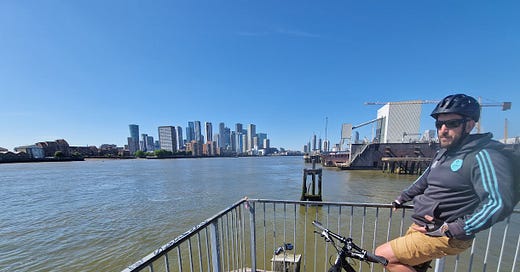



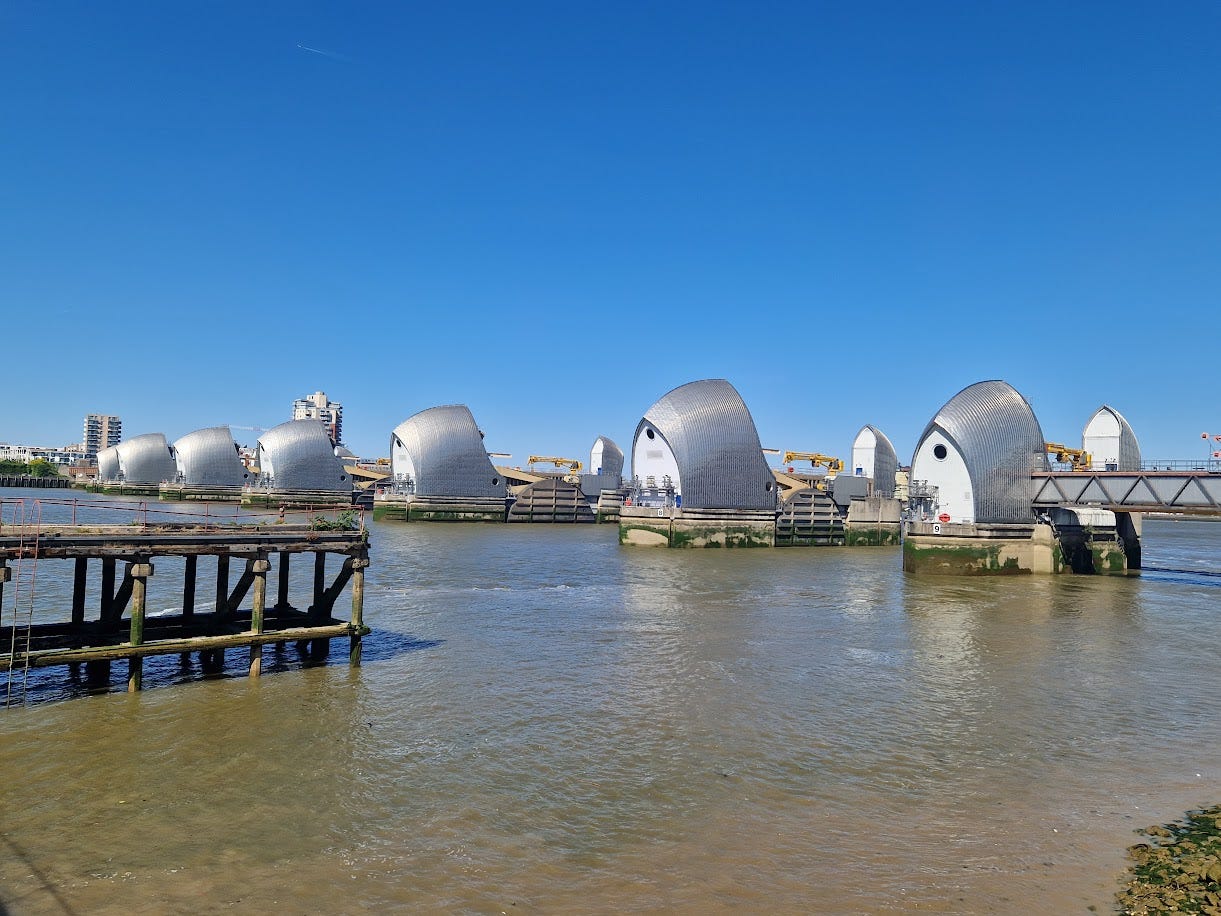
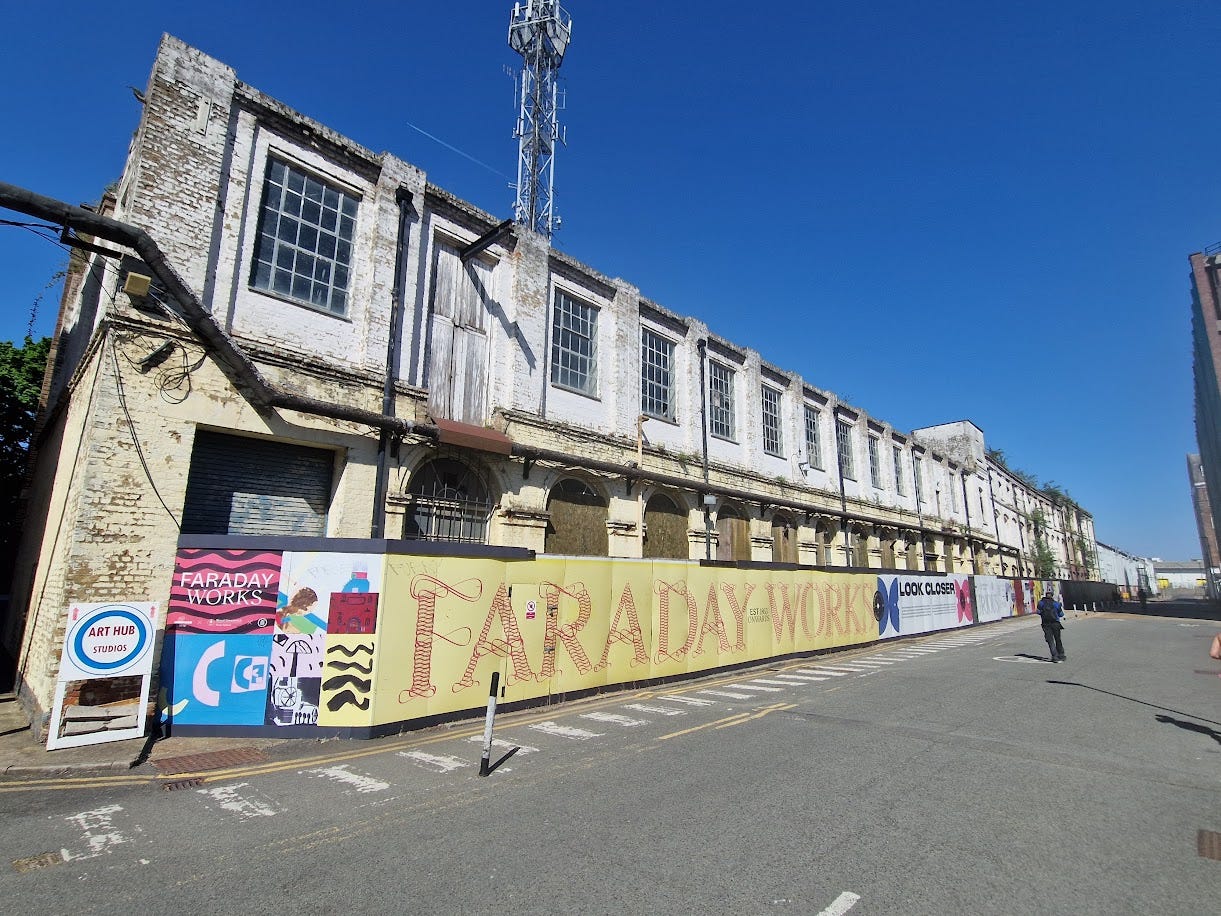
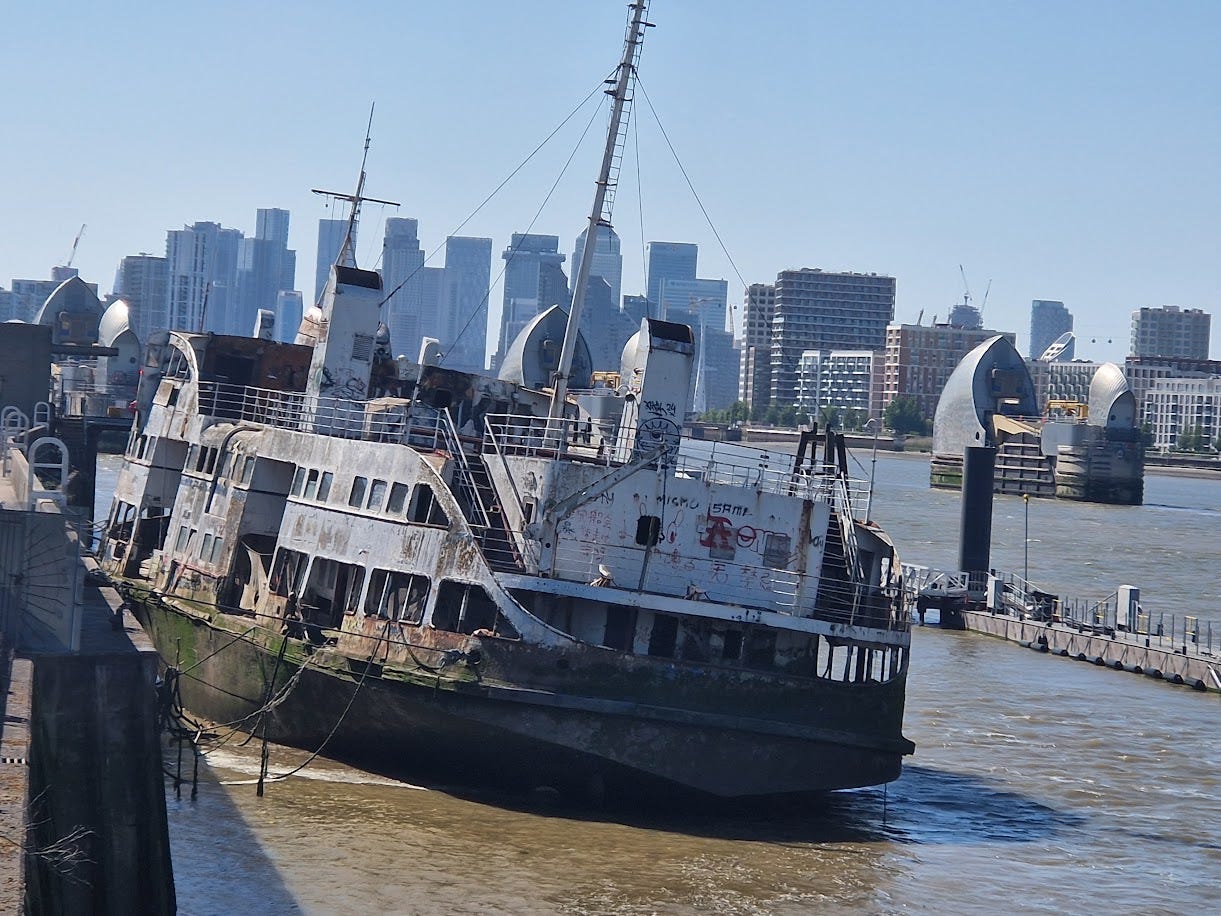

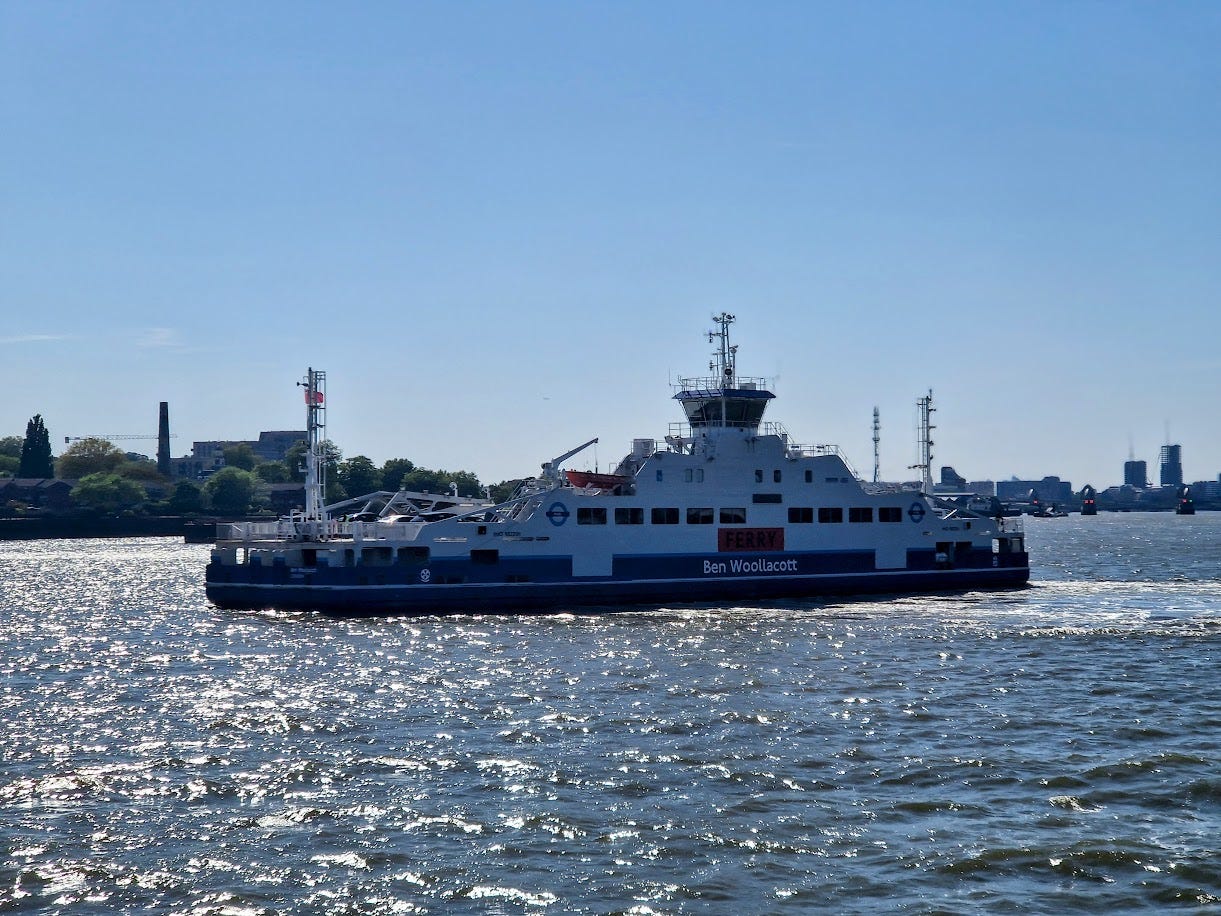

Wimpy still about? Wow!
I read the other day that in 1986, Wimpy set up a temporary branch at the Plovdiv Trade Fair in Bulgaria. This was the first time Bulgarians were introduced to western fast food. In a half-hearted effort to emulate Perestroika, the Bulgarian authorities wanted to sign a deal for Wimpy to open outlets in Bulgaria, but the trademarking costs were the stumbling block, and so no Wimpy in communist Bulgaria.
I had a very pleasant virtual trip!